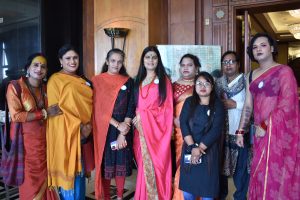International Transgender Day of Visibility 2022: Defining the visibility from a wider approach beyond the access to inclusive services

March 31 is dedicated to celebrating the existence of transgender people and raising awareness of discrimination faced by transgender people worldwide. This special day is known as the International Transgender Day of Visibility.
As per the 2011 Indian Census, the total count of transgender people in India is about 4.88 lakh. Though the estimates provided by transgender community members and organizations working for them is much higher. From time to time many studies, research has been conducted by the individuals/organisations working for them. Still, some areas need to be worked upon. For example, state-level and national-level data about the cases of discrimination faced by the same community, information about the cases where individuals were denied access to specific services including healthcare, education etc. UNDP and the World Bank published a report in 2019, that talked about five important dimensions of LGBTI inclusion index which applies for the transgender community as well:
- Political & civil participation
- Education
- Health
- Personal security and violence
- Economic well-being
Along with the rest of the dimensions mentioned above, the first one that talks about political and civil participation is a very crucial factor related to visibility concerns. Inclusive services, discrimination-free services have been much talked about and with the support of the current Government and the organisations working for the same community, the core services areas are getting improved involving the community itself. For example, National AIDS Control Organisation (NACO) has set up a technical working group involving representatives from the same community, to improvise the health programmes with a more holistic approach. Similarly, Delhi University has set up a resource centre for transgender students for helping them to access education. Though such kind of initiatives needs to be scaled up. Livelihood and legal aid service provisions need to be strengthened through a more gender-neutral lens. In various professions including Indian Police Service etc. community members are showing interest to join these days and that also needs to be scaled up in all the states.
Still along with all these developments, in terms of political and civil participation by the transgender community members there needs to be more work done. Yes, there are a couple of instances including Sabnam Mausi and others who showed their interest to represent the community through political and civil participation; but that’s a handful of instances. Anecdotal evidence says, still there are cases of discrimination happening at the family level, education and workspaces. This proves that changing the legal system or just introducing Acts is not the only way to support marginalized communities. Visibility factors are directly linked with the active and discrimination-free participation by the community in every sphere of society including political and civil participation. This also helps us to bring more visibility at the policy level and the decision making positions.
So, now the question comes how this can be possible and by whom? There are good books talking about the Indian political system, the basics of the Indian constitution and legislation processes. Basic information can be taken from these books and can be shared with the transgender community members and the leaders. There are organisations, individuals working for the same community in almost every state of India. They can start such initiatives and the transgender community leaders themselves also need to encourage their community members through proper guidance and motivation. We need to be visible in every walks of life, which cannot be limited to access to inclusive services but at the decision-making level, at the policy level that can help to work with the Government, to work with the common people and most importantly to work with the transgender community members with a more meaningful and participatory way; which can help the present system to be on a single platform where everyone can work together hand in hand and support each other.
~Written by Amrita Sarkar, Advisor: Transgender Wellbeing & Advocacy, Alliance India.
Other Recent Articles
- Yoga for Wellness: Supporting People Living with HIV & NCDs 25 June, 2025
- The Unsung Heroes of HIV Care: Outreach Workers under the Vihaan Programme 8 May, 2025
- Men’s Mental Health Matters in HIV Care 1 April, 2025
- Transforming Lives through Health Interventions: My Visit to Narmadapuram Prison 11 July, 2024
- HIV and Ageing: Understanding the Unique Needs of Older Adults 20 May, 2024
- Youth Voices: Life with HIV in Contemporary India 26 September, 2023
- Empowering Transgender Community to create an Equal World 20 July, 2023
- Combating Stigma and Discrimination Among People Living with HIV 7 July, 2023
- Understanding the Significance of HIV Testing: Impact on Individuals, Relationships, and Society 22 June, 2023
- Empowering Lives during Unrest l Our Commitment to Manipur 5 June, 2023
- Made by Nicdark - Copyright 2020
- donations@ong.com
- volunteers@ong.com
- contact@ong.com
India HIV/AIDS Alliance (Alliance India)
A not-for-profit Section 8 Company with Registration No: U85310DL1999NPL098570
Contact
-
6, Community Centre
Zamrudpur Kailash Colony Extension
New Delhi – 110048 - +91-11-4536-7700
Download
©2021 All Rights Reserved by Alliance India



